AŮo Nuevo Island White Shark Study
Methods:
Observing Predatory Behavior
You may click on the images for a larger version.
All Images are Copyrighted to the PSRF,
no use without prior written permission.
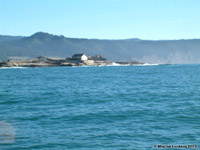 Since 1992 we have spent every single day possible on the water and/or
on the island during the months of October through January and the first week or
two of February.
Since 1992 we have spent every single day possible on the water and/or
on the island during the months of October through January and the first week or
two of February.

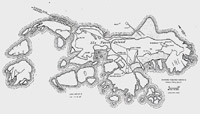
We sample 4-5 hours every morning, more if possible; this Oct we
covered every single day except for 3 separate days due to high wind/seas. This
curve diminishes as the season progresses, by February the shark are
noticeably scarce despite the high number of seals.
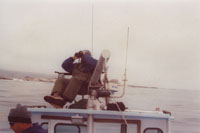
While waiting for sharks to expose themselves at the lure we keep a
sharp look out from atop the boats wheel house.

All pinniped traffic, bird activity, and surface commotions are carefully scrutinized.
We periodically use aircraft to help us keep tabs on the action:

Aircraft are excellent tools for research:

 We have learned the favored routes of incoming and outgoing pinnipeds
(seals/sealions) and will position our line of drift to intersect with
these zones of high activity.
We have learned the favored routes of incoming and outgoing pinnipeds
(seals/sealions) and will position our line of drift to intersect with
these zones of high activity.
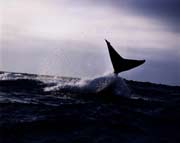 When something interesting occurs, close attention is directed at the
action.
When something interesting occurs, close attention is directed at the
action.
When a predatory event is detected or anticipated, the lure is
recovered and the research boat carefully positions for action.
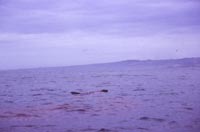
Left: a large adult female estimated 3.2 meters and half a
ton has been observed to surface a mere 100 yards out; the seal has
apparently been bitten, 0810 (am) it looks like thereís blood in the water.
The seal abruptly dove at 0811 leaving a big splash and footprint upon
the
water.

At 0814 (am) the seal is observed to re-surface approximately 60 meters
away from our boat which is still positioned a short distance from where the
seal had last been seen.
The seal is clearly distressed this time and appears to have been
bitten again.
The seal makes circles briefly at the surface and then plunges into
another dive. The sealís efforts appear labored and she looks exhausted.
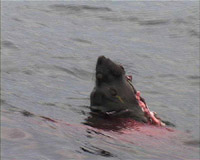
Right: (vid-grab/long-lens)
At 0821 the seal is again observed to surface a few hundred meters
away from the last sighting somewhat closer to shore behind us; this time
the seal has clearly been badly hit again, and mortally this time.
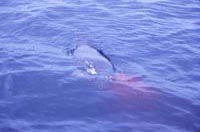
At 0824 the boat has been positioned approximately 30 meters away
as the large seal sputters around in slow circles hemorrhaging from a series
of bites delivered to the seal's head and neck; the seal is deeply
lacerated and its massive lower mandible has been fractured.
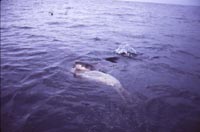
At 0828 the seal feebly dove again, it had only just vanished from
site when a large shark surfaced with the sealís head and neck completely
engulfed. The shark slowly swam across the surface with the still
twitching seal held in it's jaws.
The shark carried the seal under and disappeared; flashes seen down in
the deep, below us, suggested that the shark was now having its way with
the large seal. A large slick developed which was at least 100 meters
across. That seal never made back to the surface again.
The shark had deep scratches on the snout and side of face.
White tooth scratches on the sharks hide look like chalk marks.
A few scratches were actual cuts with faint traces of bleeding.
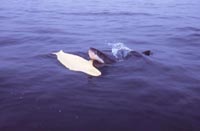
The lure was re-introduced within the slick after 20 minutes of quiet
and the shark briefly reappeared to investigated the lure.
The shark was confirmed as an estimated 5.5 meter adult female white
shark displacing close to 2 tons.
White shark predatory behavior is an interesting topic about which
there is much debate.
Many of the most cherished and conventional theories have been
disproved in the past few years.
Just knowing how to observe and understand white shark behavior is a
topic of debate.
Formerly most observations were made either from a cage with chummed-up
and fed sharks or from land based observers peering from an elevated
position on an island.
The cage diving venue was more an extreme sport activity to which
'visiting' scientists would briefly make some observations of white sharks being
fed and or teased.
In the early days this was the closest scientists ever got to a live
white shark; many scientist still pursue contact with white sharks through
the old-school 'chum and anti-shark cage' routine as it is their only
option. Feeding the sharks often involved provoking the sharks and mishaps were
not uncommon.
Innovative methods for studying white sharks were pioneered in
California during the late 1980's at the S. E. Farallone Islands by noted Point
Reyes Bird Observatory (PRBO) field researcher and naturalist Scott Anderson
and his PRBO naturalist partner and globally respected marine bird expert
Peter Pyle.
The use of un-baited lures (surfboard) and photo ID methods produced
some amazing results and the understanding of white shark behavior made a
huge leap forward during this time.
Noted elasmobranch scientist and marine science pioneer A. Peter
Klimley was mentor and valuable contributor in establishing S.E. Farallones as a
world class research site during these early years.
Without using cages or chum the Farallone researchers made many amazing
new discoveries.
In 1992, the Pelagic Shark Research Foundation began conducting
observations and lure experimentations.
Through the observations, tagging and tracking work done by the PSRF it
is now understood that:
Not all attacks occur on surface bound prey items, rather they are
quite often initiated sub-surface, especially with regards to deep diving
seals which spend relatively little time at the surface. Seals like the
northern elephant seal are often assaulted while at depth with the struggle
graduating to the surface after the initial contact has already been
engaged.
At this point an observer may mistakenly assume the attack has just
occurred when in fact it has only just then come to the observer's attention.

Right; a large adult female elephant seal surfaces after having been
badly stricken by a large shark, this seal was repeatedly assaulted while
cruising along the bottom. Not all or even most attacks occur at the surface,
especially elephant seals and harbor seals.
photo by Callaghan Fritz-Cope/PSRF
Below: often shark attacks upon seal prey targets are only detected
when they reach the surface, the action is hard to miss at times however it
is often mistaken as a surface attack when in fact the action had been
ongoing before the struggle reached the surface. The huge blood/body volume of
the deep diving e-seals often makes for the classic billows of crimson red
as sang in the old Bobby Darin hit 'Mac the Knife'. photo by Sean Van
Sommeran/PSRF
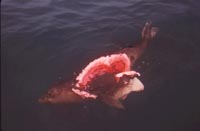
Below; a Large adult female elephant seal floats to the surface after
being badly bitten and carried by the shark for a short distance; it is a
myth that white sharks only target young elephant seals, even adult bull
seal get attacked; these upper category adult seal are the prerogative of the
largest of sharks.
photo by Sean Van Sommeran/PSRF
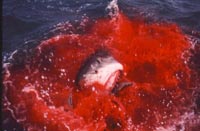
Below; a young adult male elephant seal hauls out onto the beach after
a close shave with an ambitious shark, note the bite shaped cuts on the
hind quarter. photo by J. Burn/PSRF

Below: Another popular myth is that sharks have a sensitive nose and
that by hitting a shark on the snout it will flee, wrong. This image shows the
sort of damage that white sharks are routinely subject to while killing and
biting seals, sea lions and other 'co-predator' prey items preferred by
white sharks.
White sharks are a predator of predators, thusly they have evolved to
shrug off such battle damage.
photo by Sean Van Sommeran/PSRF

Below; A mortally injured California sea lion hauls out on the rocks
after having been badly hit by a shark which has bitten off the sea lion's
tail section.
photo by PSRF staff:

below; A badly mauled California sea lion makes it clear of the water,
such hits upon California sea lions often occur near or at the surface where
the sea lions spend most of their time while traveling or resting, such
strikes often send both predator and prey out of the water in a dramatic breach
event.
photo by PSRF staff:

California sea lions porpoise across the surface, pushing hard for the
safety of the island. Sealions will often gather up in fast moving groups
while departing the island and on final approach. Often by watching traveling
sea lions you can discern by their behavior whether or not they are
being stalked or pursued by a shark or sharks.

In a PSRF experiment using a life-like sea lion lure; a large adult
white shark is induced to demonstrated a devastating surface hit on the target near
Ano Nuevo Island, California. photos by Katrina Genarro/PSRF
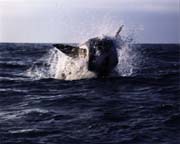
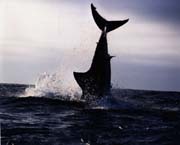

This behavior was first photo documented in California during the mid 1990's
by PRBO field researcher Scott Anderson; since then the behavior has been
noted and documented to occur in South Africa, in particular; it is now known
to be a common predatory capability of white sharks. At first, many
scientists thought that white sharks did not breach or that they only breached at
Seal Rock in Africa.
Below;
This California sea lion was bitten in half by a high-flying white shark
which breached among a small group of porpoising sealions.
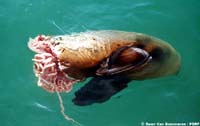
Below:
Another day at the office (R/V Mavrix); Callaghan Fritz-Cope with shark
006.

| 